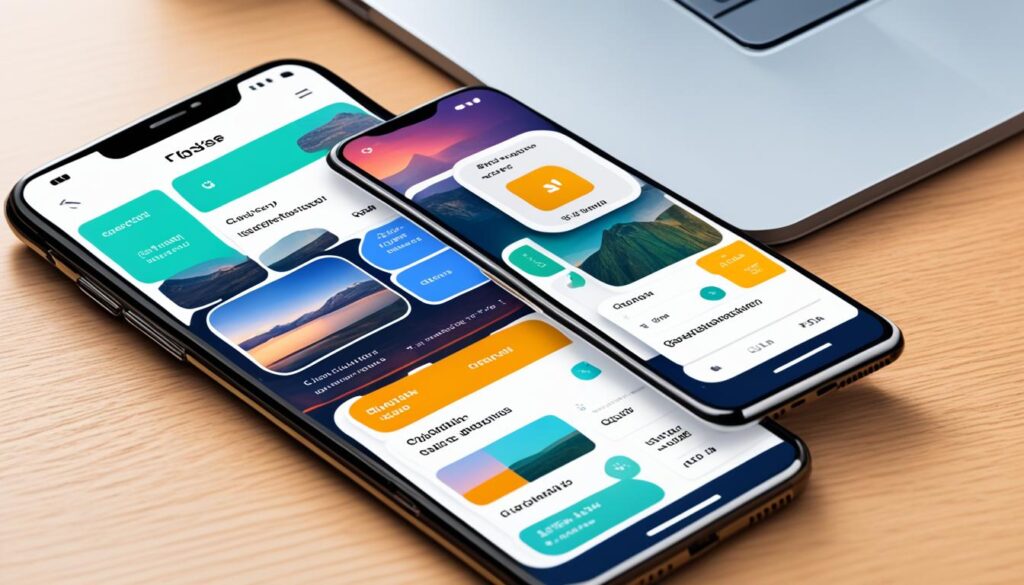Flutter: Top Pick for Cross-Platform Success
Wednesday, 4/24/2024, 9 minutes to read

In the ever-evolving landscape of mobile application development, one name consistently emerges as the front-runner for developers aiming to maximize reach and efficiency: Flutter. With its robust framework, Flutter is gaining acclaim for why it is preferred for cross-platform development. The allure of a single codebase that perfectly syncs across iOS and Android platforms, without compromising on performance or aesthetic, has positioned Flutter as a leader in the tech community. Its capacity to streamline the development process while delivering the benefits of using Flutter for cross-platform apps ensures that this tool is not just a trend, but a sustainable choice for the future of app development.
Key Takeaways
- Flutter’s single codebase fosters efficiency and consistency across multiple platforms.
- The framework’s popularity for cross-platform projects is due to its seamless performance.
- Rich, customizable widgets provide a competitive edge in user interface design.
- The rapid development cycle afforded by hot reload improves productivity.
- Robust backend solutions like Firebase integration enhance app functionalities.
Why Is Flutter a Good Choice for Cross-Platform Projects?
In the realm of mobile app development, the strategic selection of a cross-platform framework can drastically influence the project’s efficiency and outcome. Flutter emerges as a powerful contender, and the reasons for its growing acclaim are rooted in the features it offers that cater directly to developer necessities and project aims. Let’s explore the characteristics of Flutter that underscore its suitability for cross-platform projects, delivering a seamless app performance and comprehensive flutter features for mobile app development.
Unified Codebase for Multiple Platforms
One paramount consideration when answering why is Flutter a good choice for cross-platform projects? is its unified codebase functionality. Flutter enables developers to write one set of code that is deployable across multiple operating systems, including Android and iOS. This not only streamlines the development process but also alleviates the burden of maintaining separate codebases for different platforms, leading to appreciable savings in time and resources.

Hot Reload for Enhanced Development Speed
The Hot Reload feature is another sterling aspect of Flutter, which appeals overwhelmingly to developers. Its real-time capability to inject updated source code into a running Dart Virtual Machine (VM) means changes can be glimpsed instantaneously without needing a full restart of the application. This feature elevates flutter for seamless app performance, offering a swift iterative development experience that accelerates the build and debugging cycles. Developers can now see their modifications in action in a matter of seconds, which significantly hastens the pace of app creation.
Expansive Widget Library for Rich UIs
A rich and intuitive user interface is non-negotiable in today’s application standards. Flutter’s expansive library of widgets plays an instrumental role in the framework’s ability to deliver visually attractive and highly responsive user interfaces. These widgets are a pivotal flutter feature for mobile app development, as they can be customized and used to craft intricate UIs that seem native to the platform. The sheer variety and extensibility of Flutter’s widgets empower developers to bring creative and functional interfaces to life with relative ease and finesse.
In conclusion, the trifecta of a unified codebase, hot reload, and an extensive widget library are compelling answers to why is Flutter a good choice for cross-platform projects? Offering versatility, speed, and aesthetic prowess, Flutter stands out as a leading choice for developers intent on crafting high-quality cross-platform apps.
Flutter Advantages Over Other Cross-Platform Tools
When evaluating flutter vs other cross-platform tools, developers seek efficiency and a streamlined development cycle. Flutter emerges as a comprehensive framework, known for its fast and flexible development capabilities. Among the top reasons to choose Flutter for cross-platform projects, the high-performance Dart language foundation and extensive widget library are pivotal, contributing to robust and visually appealing applications.
The developer experience with Flutter is greatly enhanced thanks to features like hot reload, which allows immediate viewing of code changes in action—a luxury that’s not as seamlessly available in tools such as Xamarin or React Native. Furthermore, the Flutter framework pushes the envelope on performance, providing near-native speed thanks to its direct compilation to ARM or x86 native libraries, surpassing many other frameworks that rely on bridge technologies or webview wrappers.
| Feature | Flutter | React Native | Xamarin |
|---|---|---|---|
| Programming Language | Dart | JavaScript | C# |
| UI Consistency | High (rich widget sets) | Medium (component-based) | Medium (platform renderers) |
| Performance | High (compiled to native code) | High (but relies on JS bridge) | High (but heavier apps) |
| Hot Reload | Supported | Supported | Limited |
| Community Support | Expanding rapidly | Large | Stable |
Community support plays a pivotal role in the sustainability and evolution of development tools. The Flutter community has seen remarkable growth, with an abundance of resources, plugins, and support channels that help facilitate developer collaboration and knowledge sharing. This burgeoning community is swiftly positioning Flutter as the framework of choice for those looking to achieve a consistent UI and seamless app performance across platforms.
- Unified codebase reducing development time and resources
- Comprehensive widget library simplifying complex UI creation
- Hot reload capability enhancing the developer workflow
- Strong performance matching native app standards
- Expansive and supportive developer community
Prioritizing performance and user experience, Flutter stands out by offering the seamless integration of a cross-platform approach without the common pitfalls associated with other frameworks.
Key Flutter Features for Mobile App Development
Flutter has emerged as a game-changer for developers aiming to deliver top-notch cross-platform applications. Among its many advantages, a handful of features stand out for their power to streamline the development process and deliver a product that rivals native app performance on both major platforms. Let’s explore these features in detail.
Customizable and Reusable Widgets
One of the most significant benefits of using Flutter for cross-platform apps is its rich set of customizable and reusable widgets. These flexible building blocks are tailored to mimic native controls and can be personalized to the nth degree, allowing developers to craft a unique and intuitive user interface. The ease of widget customization is a testament to Flutter’s commitment to developer efficiency and design finesse.
Native Performance on Both Android and iOS
Delivering native performance on both Android and iOS is a hallmark of Flutter’s technical prowess. By compiling to native ARM code, Flutter ensures that apps run smoothly and responsively, providing a seamless experience for users on different devices. This capability places Flutter at the forefront of cross-platform solutions, offering the kind of performance that end-users expect from top-tier applications.
Robust Backend Support with Firebase
Flutter’s integration with Firebase offers developers robust backend support, simplifying tasks such as data storage, real-time updates, authentication, and more. Firebase’s suite of cloud services complements Flutter’s front-end capabilities, allowing for the creation of dynamic, feature-rich applications with minimal hassle. This powerful combination paves the way for developers to implement complex backend functionalities with greater ease and reliability.

Collectively, these features of customizable and reusable widgets, native performance, and robust backend support with Firebase, constitute the cornerstone of Flutter’s architecture. These advantages translate into tangible benefits for businesses and developers alike, pushing the boundaries of what can be achieved in cross-platform app development while maintaining high quality and cost-effectiveness.
Conclusion
In summary, this article has articulated compelling reasons why Flutter is a good choice for cross-platform projects. Flutter’s unified codebase is a cornerstone of its architecture, effectively bridging the gap between the Android and iOS platforms, thus streamlining the development pipeline. Moreover, the hot reload feature is a testament to the framework’s commitment to elevating developer efficiency and productivity, which in turn can lead to a more dynamic and iterative design process.
The advantages of Flutter go beyond just its impressive toolset. With the provision of a rich widget library, it empowers developers to build aesthetically appealing and highly customizable user interfaces. The framework’s capacity for delivering native performance across different platforms ensures that the end-users enjoy an experience that is smooth, responsive, and consistent, no matter the device in use. By aiding developers to leverage these flutter advantages, cross-platform development with Flutter becomes a robust and viable strategy for crafting quality applications.
As we have explored throughout this piece, the value proposed by cross-platform development with Flutter is multifaceted. Strong community support, combined with robust backend integration capabilities, especially with Firebase, underpins Flutter’s ecosystem. It is this confluence of features, flexibility, and performance gains that positions Flutter as a preferred framework for developers and organizations around the globe. Having a solid understanding of Flutter’s capabilities, we can clearly see the strategic advantage it offers in today’s competitive landscape of mobile app development.
FAQ
Why is Flutter preferred for cross-platform development?
Flutter is preferred for cross-platform development due to several compelling features such as its unified codebase, which allows developers to write one code for both Android and iOS platforms. It also offers widgets that provide a rich and native performance, a hot reload feature to accelerate the development cycle, and seamless integration with backends like Firebase. All these contribute to Flutter’s appeal for efficiently creating high-quality apps.
What are the benefits of using Flutter for cross-platform apps?
The benefits of using Flutter include reduced code development time, cost-effectiveness by reusing the same code across multiple platforms, consistent UI/UX on different devices, and a less steep learning curve for new developers. It also simplifies maintenance and updating of apps, thanks to its single codebase.
How does Flutter’s unified codebase impact mobile app development?
Flutter’s unified codebase means that developers can write once and deploy their apps across multiple platforms including Android and iOS, without the need to change the code for each platform. This leads to greater efficiency, reduced development time and costs, and easier maintenance.
What makes Flutter’s hot reload feature advantageous for developers?
Flutter’s hot reload feature allows developers to see the changes they make to the code in real-time without the need for a full app restart. This accelerates the development process, enhances productivity, and helps in quickly experimenting with UI designs or fixing bugs.
Why might a developer choose Flutter over other cross-platform tools like React Native or Xamarin?
Developers might prefer Flutter over other cross-platform tools for its seamless app performance, consistent UI across platforms, wider array of customizable widgets, and the ability to deliver native experience on both Android and iOS. Flutter also has a strong community, good documentation and supports modern programming concepts which may not be as pervasive in other frameworks.
What are some of the top reasons to choose Flutter for cross-platform projects?
Top reasons to choose Flutter include its strong focus on UI with a rich set of customizable widgets, rapid development with hot reload, high performance similar to native apps, and powerful integrations with popular backends like Firebase. The ease of learning and the growing community contribute as well to it being a top choice for cross-platform development projects.
Other blog posts
Transform your business with innovative technology solutions
Contact us — we'd love to talk about your idea!
📝 Get an Estimate